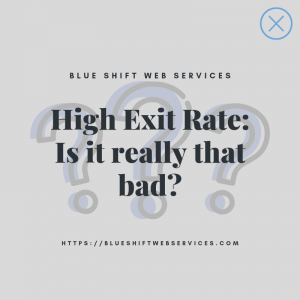Is having a high exit rate bad? In pursuit determining whether Google is using analytics data to ranks SERPS, many marketers put undue focus and weight on factors like bounce rate and exit rate instead of taking a more holistic look at the statistics in relation to one another and what they really mean.
Is having a high exit rate bad? It depends. To understand the problem, we need to take a step back. Every analytics program will differ slightly, but exit rate technically means this is the last page someone visited on your website. The real question is whether someone left because they reached a logical conclusion or found the answer to what they where looking for–or whether they left because they didn’t.
As an example, if you have an article series on the best website hosting services, and you did it head and tail style, it would make sense that tail piece number 5 would have a higher exit rate than tail piece number 1. However, if your head piece has a high exit rate, then you probably didn’t do a good enough job of creating linkbait that matched your title.
Another factor you need to look at is time on site.
These pages have a high exit rate but also have a high on site time. This usually means the people are reading the content and it is helpful. Compare that to the page below with a high exit rate of x% and low on site time of x%
Some pages will have a high exit rate because they are the final step in a process, like checkout confirmation, or email subscription. If you use affiliate links and mask them through a redirect, that redirect page will have a high exit percentage as well. I recommend blocking bounce/redirect pages in most cases, but sometimes there are exceptions.
Other factors to consider are advertising income, affiliate commissions, social interaction, bookmarking, and printing. For example, some tutorial pages or information pages have a high likelihood of being printed. Consider all these Search Engine Optimization factors before rewriting, updating, or deleting a page.
So what are the takeaways from this post:
- Try to identify pages with a high exit rate as part of your regular content audit.
- Try to determine if the high exit rate is because it’s part of the flow or natural process, like end of content series or checkout process.
- Look at other factors, such as time on site, social bookmarking, sharing, or printing.
- Only when you have determined that a page isn’t doing its intended function, should you update, rewrite, or delete the page.



